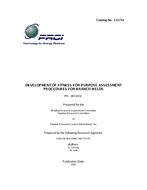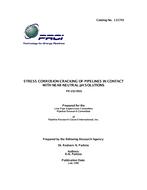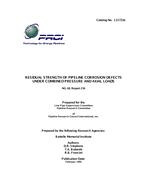Provide PDF Format
PRCI PR-185-9332
- Development of Fitness-for-Purpose Assessment Procedures for Branch Welds
- Report / Survey by Pipeline Research Council International, 07/27/1994
- Publisher: PRCI
$25.00$49.00
L51714e
Edison Welding Institute
Need: One major difficulty in developing fitness-for-purpose based flaw acceptance criteria for pipeline branch connections is the calculation of the stress distributions in the vicinity of the welds. Even with the latest computer aided modeling technologies, direct finite element modeling of branch connections using 3-D solid elements can be time consuming and cost prohibitive. Therefore, it is necessary to investigate the possibility of using more computationally-efficient finite element approaches to determine the stress distributions local to branch connections.
Benefit: This report describes work to develop flaw acceptance criteria based on fitness-for-purpose principles for branch connections in pipelines. The effort concentrated on investigating finite element modeling methodologies to predict accurately the stress distributions local to branch connections. These stress distributions can be used to develop fitness-for-purpose based flaw acceptance criteria that are consistent with those already developed for girth welds.
Result: None of the three shell element modelling strategies investigated provide consistently accurate or conservative predictions of crack opening stress for all loading modes, positions around the pipe-to-pipe intersection, and crack depths. Shell element models are therefore not a reliable alternative to solid element models for predicting the stresses in the vicinity of a welded branch connection that are needed as input to a fitness-for-purpose assessment. Conversely, a modelling strategy which combines shell and solid elements did predict acceptably accurate stresses in comparison with solid element modelling. However, these models are difficult to prepare and provide only a marginal reduction in run time compared with solid element models. Thus, while this modelling strategy is acceptably accurate, the benefit it provides is outweighed by difficulties associated with it's implementation.
Edison Welding Institute
Need: One major difficulty in developing fitness-for-purpose based flaw acceptance criteria for pipeline branch connections is the calculation of the stress distributions in the vicinity of the welds. Even with the latest computer aided modeling technologies, direct finite element modeling of branch connections using 3-D solid elements can be time consuming and cost prohibitive. Therefore, it is necessary to investigate the possibility of using more computationally-efficient finite element approaches to determine the stress distributions local to branch connections.
Benefit: This report describes work to develop flaw acceptance criteria based on fitness-for-purpose principles for branch connections in pipelines. The effort concentrated on investigating finite element modeling methodologies to predict accurately the stress distributions local to branch connections. These stress distributions can be used to develop fitness-for-purpose based flaw acceptance criteria that are consistent with those already developed for girth welds.
Result: None of the three shell element modelling strategies investigated provide consistently accurate or conservative predictions of crack opening stress for all loading modes, positions around the pipe-to-pipe intersection, and crack depths. Shell element models are therefore not a reliable alternative to solid element models for predicting the stresses in the vicinity of a welded branch connection that are needed as input to a fitness-for-purpose assessment. Conversely, a modelling strategy which combines shell and solid elements did predict acceptably accurate stresses in comparison with solid element modelling. However, these models are difficult to prepare and provide only a marginal reduction in run time compared with solid element models. Thus, while this modelling strategy is acceptably accurate, the benefit it provides is outweighed by difficulties associated with it's implementation.
Related Products
PRCI PR-232-9501
Stress Corrosion Cracking of Pipelines in Contact with Near-Neutral Solutions..
$325.00 $649.00
PRCI Report 216
Residual Strength of Pipeline Corrosion Defects Under Combined Pressure and Axial Loads..
$498.00 $995.00
PRCI NG - 18 Report 167
Surface Effects on Stress Corrosion Susceptibility of Line Pipe Steels..
$48.00 $95.00





